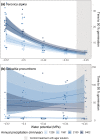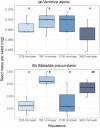A test of local adaptation to drought in germination and seedling traits in populations of two alpine forbs across a 2000 mm/year precipitation gradient
- PMID: 36778839
- PMCID: PMC9905427
- DOI: 10.1002/ece3.9772
A test of local adaptation to drought in germination and seedling traits in populations of two alpine forbs across a 2000 mm/year precipitation gradient
Abstract
Seed regeneration is a critical stage in the life histories of plants, affecting species' abilities to maintain local populations, evolve, and disperse to new sites. In this study, we test for local adaptations to drought in germination and seedling growth of two alpine forbs with contrasting habitat preferences: the alpine generalist Veronica alpina and the snowbed specialist Sibbaldia procumbens. We sampled seeds of each species from four populations spanning a precipitation gradient from 1200 to 3400 mm/year in western Norway. In a growth chamber experiment, we germinated seeds from each population at 10 different water potentials under controlled light and temperature conditions. Drought led to lower germination percentage in both species, and additionally, slower germination, and more investment in roots for V. alpina. These responses varied along the precipitation gradient. Seeds from the driest populations had higher germination percentage, shorter time to germination, and higher investments in the roots under drought conditions than the seeds from the wettest populations - suggesting local adaption to drought. The snowbed specialist, S. procumbens, had lower germination percentages under drought, but otherwise did not respond to drought in ways that indicate physiological or morphological adaptions to drought. S. procumbens germination also did not vary systematically with precipitation of the source site, but heavier-seeded populations germinated to higher rates and tolerated drought better. Our study is the first to test drought effects on seed regeneration in alpine plants populations from high-precipitation regions. We found evidence that germination and seedling traits may show adaptation to drought even in populations from wet habitats. Our results also indicate that alpine generalists might be more adapted to drought and show more local adaptations in drought responses than snowbed specialists.
Keywords: biomass allocation; polyethylene glycol; seed mass; time to 50% germination; time to max germination.
© 2023 The Authors. Ecology and Evolution published by John Wiley & Sons Ltd.
Conflict of interest statement
The authors declare no conflict of interest.
Figures






Similar articles
-
Germination and seedling growth of Calluna vulgaris is sensitive to regional climate, heathland succession, and drought.Ecol Evol. 2023 Jul 4;13(7):e10199. doi: 10.1002/ece3.10199. eCollection 2023 Jul. Ecol Evol. 2023. PMID: 37408632 Free PMC article.
-
Local adaptation of seed and seedling traits along a natural aridity gradient may both predict and constrain adaptive responses to climate change.Am J Bot. 2022 Oct;109(10):1529-1544. doi: 10.1002/ajb2.16070. Epub 2022 Oct 13. Am J Bot. 2022. PMID: 36129014 Free PMC article.
-
Intraspecific variations in seedling emergence and survival of Potentilla matsumurae (Rosaceae) between alpine fellfield and snowbed habitats.Ann Bot. 2003 Jan;91(1):21-9. doi: 10.1093/aob/mcg002. Ann Bot. 2003. PMID: 12495916 Free PMC article.
-
Seed dormancy and germination changes of snowbed species under climate warming: the role of pre- and post-dispersal temperatures.Ann Bot. 2016 Sep;118(3):529-39. doi: 10.1093/aob/mcw125. Epub 2016 Jul 6. Ann Bot. 2016. PMID: 27390354 Free PMC article.
-
Comparative seed germination traits in alpine and subalpine grasslands: higher elevations are associated with warmer germination temperatures.Plant Biol (Stuttg). 2017 Jan;19(1):32-40. doi: 10.1111/plb.12472. Epub 2016 Jun 6. Plant Biol (Stuttg). 2017. PMID: 27203239
Cited by
-
Registered Reports: A new chapter at Ecology & Evolution.Ecol Evol. 2023 Apr 27;13(4):e10023. doi: 10.1002/ece3.10023. eCollection 2023 Apr. Ecol Evol. 2023. PMID: 37122770 Free PMC article.
-
Seed Germination and Seedling Growth in Suaeda salsa (Linn.) Pall. (Amaranthaceae) Demonstrate Varying Salinity Tolerance among Different Provenances.Biology (Basel). 2023 Oct 18;12(10):1343. doi: 10.3390/biology12101343. Biology (Basel). 2023. PMID: 37887053 Free PMC article.
-
Germination and seedling growth of Calluna vulgaris is sensitive to regional climate, heathland succession, and drought.Ecol Evol. 2023 Jul 4;13(7):e10199. doi: 10.1002/ece3.10199. eCollection 2023 Jul. Ecol Evol. 2023. PMID: 37408632 Free PMC article.
References
-
- Adams, R. (1999). Germination of Callitris seeds in relation to temperature, water stress, priming, and hydration‐dehydration cycles. Journal of Arid Environments, 43(4), 437–448. 10.1006/jare.1999.0567 - DOI
-
- Albrecht, M. A. , & McCarthy, B. C. (2009). Seedling establishment shapes the distribution of shade‐adapted forest herbs across a topographical moisture gradient. Journal of Ecology, 97(5), 1037–1049. 10.1111/j.1365-2745.2009.01527.x - DOI
-
- Allen, G. A. , Marr, K. L. , Mccormick, L. J. , & Hebda, R. J. (2015). Geographical origins, migration patterns and refugia of Sibbaldia procumbens, an arctic‐alpine plant with a fragmented range. Journal of Biogeography, 42(9), 1665–1676. 10.1111/jbi.12543 - DOI
LinkOut - more resources
Full Text Sources

